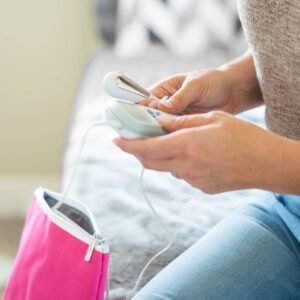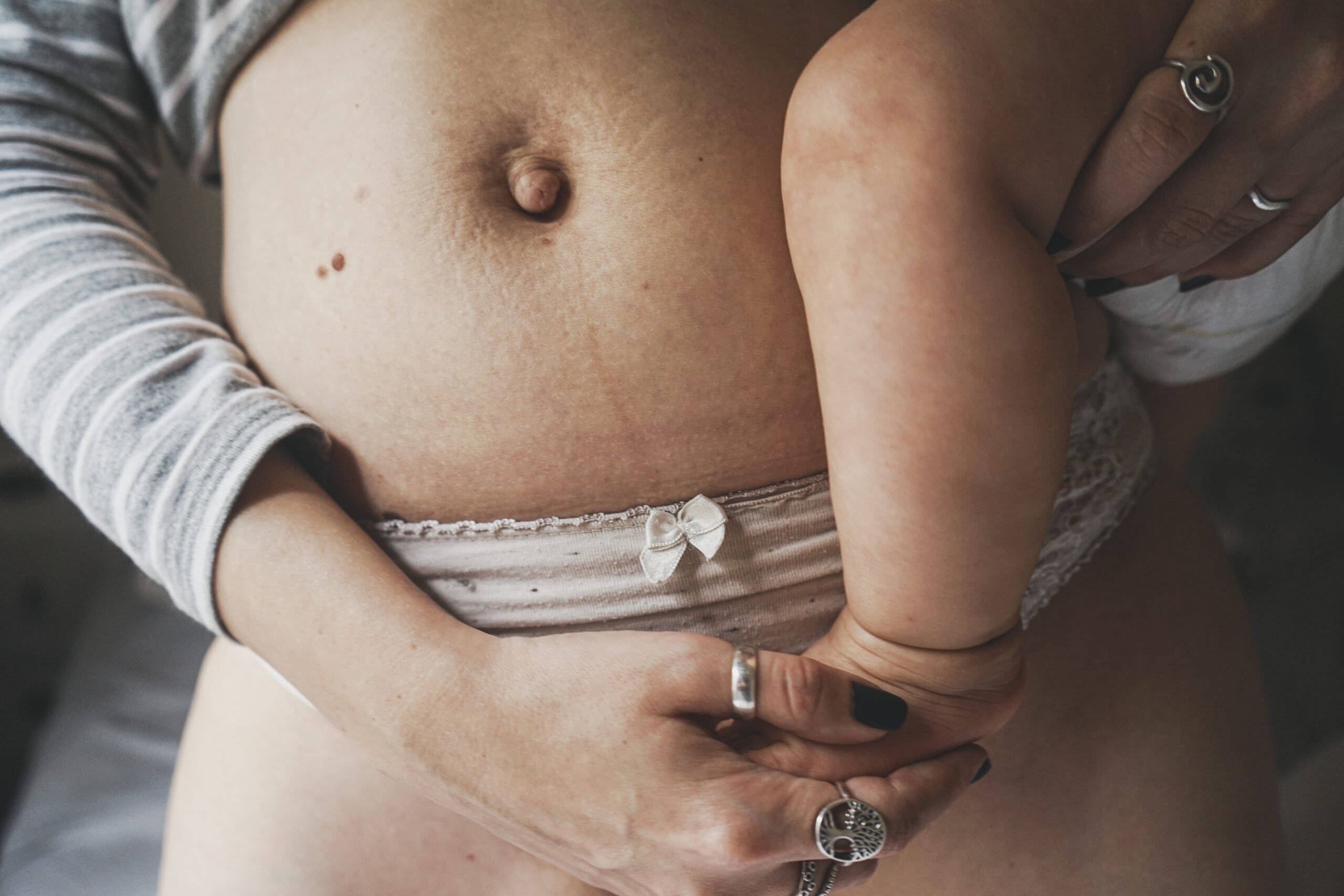Pregnancy and childbirth are extraordinary life events. While there are (obviously) challenges in both, they can be fulfilling and powerful.
But once the fulfilling and powerful emotions coursing through your veins subside, you may realize that your body feels… different. Not necessarily bad, not necessarily good. Just different.
To be fair, your body should feel different. You grew an entire human and now — with absolutely no break — you’re responsible for taking care of it. You’re exhausted and depleted and just trying to stay afloat. So thinking about postpartum incontinence isn’t really at the top of your list.
We can hardly blame you. It’s a stressful time, but it should also be a joyous time. Something as fundamental as not peeing your pants shouldn’t be a thing you’re worried about.
Here’s what you need to know about bladder leakage postpartum and the urinary incontinence treatment options available to you — hint, hint: Yarlap Autokegel device.
Rude Awakenings with Postpartum Incontinence
Many women are completely unaware that incontinence after childbirth is even a thing. It’s just not something that’s taught in the baby classes — at least not in the United States.
Additionally, women are often told — by friends, family, and society — that urinary incontinence is “just a part of motherhood.” If that many people experience it, it becomes normalized, even if it’s not normal at all.
Experiencing bladder leakage is so common, it’s joked about at baby showers and in friend groups full of moms.
All of the childbirth preparation classes are designed to get you mentally prepared for the labor and try to teach you how to push without actually pushing. They talk a lot about the baby and how to care for it after its arrival (how to swaddle, change a diaper, safety dos and don’ts, etc).
Even after you have the baby, nurses and doctors are more concerned about the baby than they are about you. They’re not intentionally ignoring you. Babies are more difficult to care for because they can’t talk.
And also, they’re cute. They’re going to steal the attention. 
So by the time you get your tiny human home, there’s been very little discussion about what you can expect from your own body moving forward. You’re sent home with a squirt bottle, giant pads, and extra pairs of the most ridiculous underwear anyone has ever seen.
If you’re in the U.S., chances are that no one discussed your healing past the initial physical trauma. In six weeks, you’ll go in for your one and only postpartum checkup (assuming there weren’t any major complications), and then your OB/GYN will send you back home.
But what about any other questions you have? What if things haven’t returned totally to normal? What if you’re experiencing postpartum incontinence? Is that even normal? If so, how long should you expect it to last?
All of these are questions our current system of postpartum care is neglecting.
Why Do Some Women Experience Incontinence After Childbirth?
Pregnancy and childbirth are physically traumatic events — not to mention emotionally, but the emotional trauma won’t affect your pelvic floor in the same way, so we’ll stay on task.
While many women look at childbirth as doing the most damage to their pelvic floors, it’s actually pregnancy that often has the greatest impact.
Childbirth is definitely tough on the pelvic floor because of the physical act of pushing. You’re forcefully trying to push a baby out of a very narrow passageway. If you’ve ever seen those images of what dilation looks like (5 centimeters, 7 centimeters, etc) next to a newborn baby’s head, you know how intimidating childbirth can be.
There are certain things that can have a more detrimental effect on the pelvic floor during childbirth. Emergency cesareans can cause more damage, as can particularly difficult pushing, an odd fetal position, or long labor.
However, these are relatively short-term as far as the timeline goes. C-sections will be over within the hour, labor is usually a matter of a day or two (hopefully not more!). Pushing probably won’t be more than a couple of hours.
But pregnancy is 40 weeks. That’s a lot of time for your pelvic floor to take a beating.
Between extra weight, your body stretching to make room for the growing fetus, increased pressure on your bladder, and your fetus using that convenient bladder placement for target practice, urinary incontinence is quite common among pregnant women.
Yes, but what about postpartum incontinence?
Regardless of how your baby is born, the strain on your pelvic floor has already occurred during the previous 40 weeks.
If you have a traditional birth, your body will return to normal in a few weeks (it’s remarkably resilient). Your organs will all go back to their regular position and your uterus will shrink down. Your body will get used to moving the way it used to again simply by you moving around.
But your pelvic floor muscles are more difficult to reach, and therefore more difficult to re-train. If they were weak to begin with, your battle is a bit more uphill.
“One of the main functions of our pelvic floor muscles is to prevent urinary incontinence by supporting our pelvic organs,” says Ashley Rawlins, PT, DPT at Origins. “Being strong enough to protect against increases in intra-abdominal pressure (think coughing, running, or laughing), can be very provocative of leakage.”
A number of women experience postpartum incontinence just after childbirth. It’s pretty common. This begs the question: how long is incontinence after childbirth considered “normal?”
Is it Normal to Have Postpartum Incontinence for Years?
Some postpartum women only experience urinary incontinence for a few days after childbirth, while others experience it for weeks. While this could be normal in your circumstances, it’s always a good idea to check with your doctor.
Since you’ll be going in for your 6-week postpartum checkup, that’s a good time to bring up bladder leakage if you’re still experiencing it. Your OB/GYN will likely have some recommendations and may have a pelvic floor specialist they refer their patients to.
Dr. Brynna Connor, Healthcare Ambassador for NorthWestPharmacy.com, is a family medicine practitioner with an undergraduate degree in psychology, and she doesn’t let this topic fall to the wayside. “[My patience] try to accept postpartum incontinence — until I ask them about it,” says Dr. Connor.
Thanks to her psychology background and years of practicing family medicine, she knows the emotional toll incontinence has on her patients. More importantly, she knows women don’t have to suffer through it.
Dr. Connor says that some of her female patients suffer from bladder leakage for years before ever mentioning it to her. “Many women think it is normal and a part of aging,” she says, “or just what happens to their bodies as a result of having children, and are hesitant to get help for it. They think they just have to live with it.”
There are always exceptions to the rule, but most women can effectively treat their urinary incontinence. Doing so will undoubtedly improve their quality of life. But with all the shame surrounding bladder leakage, women often struggle to broach the topic with their doctor.
According to Dr. Connor, her patients typically bring up their struggle with urinary incontinence when it begins to affect their daily lives. “Sometimes [bladder leakage] is unexpected,” she says, “but if they have to know where all the restrooms are wherever they go, it creates undue stress for them emotionally.”
Urinary Incontinence Treatment for Postpartum Women
The general consensus among medical professionals is that Kegel exercises are an effective method of postpartum incontinence treatment. 
While every situation — and every individual body — is different, a strong, fully functional pelvic floor is an important step in maintaining bladder control, as well as feminine health. Of course, to strengthen and maintain any muscle, you have to use it.
If you take the example of lifting weights, you can easily transfer that logic. If you’re trying to gain strength in your upper body, you need to do push-ups and overhead lifts (among other movements) on a regular basis.
When we lift weights, microscopic tears are formed in the muscles. While that may sound like a bad thing, it’s actually good. When the muscles heal, they’re stronger. (Fun fact: it’s this tearing that makes you sore.)
Because your pelvic floor is made up of a series of muscles, you need to exercise them in order to strengthen this “hammock” of muscles. This particular exercise is called a Kegel exercise, named for Dr. Arnold Henry Kegel, who is believed to be the first person to define pelvic floor exercises.
What about pelvic floor therapy?
In Europe, it’s more commonplace for postpartum women to be referred to pelvic floor therapy. For whatever reason, such recommendations aren’t as common in the U.S. — and American women are suffering because of it.
There is some hope that the tide is changing. For example, Dr. Connor says that she recommends pelvic floor exercises to her female patients all the time, and she isn’t the only one. Pelvic floor therapy is finally being acknowledged as an important part of postpartum care.
“Pelvic physical therapy is highly effective at managing urinary incontinence,” says Dr. Rawlins. “In fact, the International Continence Society (ICS) recommends pelvic floor muscle training, lifestyle and behavioral modifications, and bladder retraining as the first-line treatment for bladder leakage.”
It’s the pelvic floor exercises that introduce Kegels. Kegel exercises are a contraction and relaxation of the muscles that make up the pelvic floor. It’s the same concept as doing a bicep curl or a squat.
(Sidenote on squats: be careful with them. Repeated weights can strain the muscles you’re trying to tone. This is one reason why women who work in warehouses and female weightlifters often have bladder control issues.)
The main difference is that it’s difficult to determine if you’re doing Kegels correctly. Think about it — you can do squats with poor form, but a trainer can correct you, and once you learn proper form, you can correct yourself by looking in a mirror.
But with Kegels, every muscle you’re engaging is hidden. No one can demonstrate a proper Kegel in a visual way that shows you what you’re doing wrong.
In fact, many women do Kegels incorrectly and they don’t even realize it. We know this because so many of our customers have told us so and our research backs it up.
It’s with this knowledge that we developed the Yarlap Autokegel device — a pelvic floor trainer that does a perfect Kegel for you, every single time.
How the Yarlap Autokegel Device May Help You
The Yarlap Autokegel device is based on scientific research and may be a helpful addition to pelvic floor therapy. 
The Yarlap Autokegel device is an award-winning product for a very good reason — it works. It’s been proven time and time again to reduce urinary incontinence. It’s so effective, it’s been FDA-cleared.
We’re very proud of our Yarlap Autokegel device and our customer testimonials consistently reinforce our mission. We love helping women live more fulfilling lives. Bladder leakage shouldn’t be a thing they need to worry about, among the rest of their crushing mental load.
We know the Yarlap Autokegel device works, but you really shouldn’t take our word for it. Please check out the customer reviews here, which include Amazon reviews from customers completely unafraid of offending us or hurting our feelings. (Not that people on the internet seem to be overly concerned about that anyway.)
If you’ve taken nothing else from this article, we want you to remember this:
- You’re not alone.
- More women than you realize are struggling with urinary incontinence.
- Urinary incontinence treatment options are available.
“There is help, and it might be easier than you think to resolve,” says Dr. Connor. We couldn’t agree more, and we’re so glad to find practitioners who want to help their patients cure their urinary incontinence.
If you’d like to learn more about the Yarlap Autokegel device, there are plenty of resources available to you. You’re welcome to give us a call at (614) 568-7000 and we’ll answer any questions over the phone, or you can check out our frequently asked questions page to see if the answer you’re looking for is already provided.
But if you’ve seen all you need to see and you’re ready to start Yarlapping, you can visit our website. We’re looking forward to helping you rid your life of urinary incontinence, once and for all!
DISCLAIMER: THIS WEBSITE, YARLAP, AND RLI, INC. DO NOT PROVIDE MEDICAL ADVICE OR DIAGNOSIS.
The information, including but not limited to, text, graphics, images and other material contained on this website are for informational purposes only. Any information published on this website or by this brand is not intended as a substitute for professional medical guidance and should not be used during any medical emergency or for the diagnosis or treatment of any medical condition. Always seek the advice of your physician or other qualified health care provider with any questions you may have regarding a medical condition or treatment and before undertaking a new health care regimen, and never disregard professional medical advice or delay in seeking it because of something you have read on this website. Links to other sites are provided for information only – they do not constitute endorsements of those other sites or any recommendations or advice contained therein.



